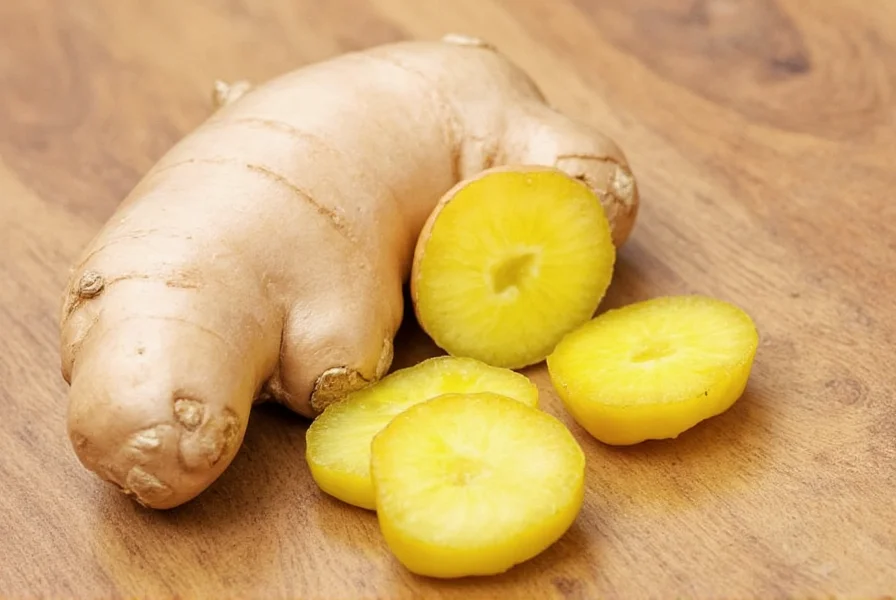Proper ginger storage preserves its pungent flavor and fibrous texture while preventing mold and spoilage. Whether you've bought a large root at the market or have leftovers from a recipe, understanding the science behind ginger preservation helps maximize both shelf life and culinary quality.
Refrigerator Storage: The Standard Method
Refrigeration remains the most practical approach for most home cooks. The cool, humid environment of your vegetable drawer slows down the natural decomposition process while maintaining ginger's firm texture.
Step-by-Step Refrigerator Storage
- Keep ginger unpeeled—the skin acts as a natural protective barrier
- Place in an airtight container with a folded paper towel to absorb excess moisture
- Store in the vegetable drawer (crisper) where humidity is higher
- Check weekly and replace the paper towel if damp
This method works because ginger naturally contains high moisture content (around 80%). The paper towel absorbs condensation that would otherwise create a mold-friendly environment. Properly stored, fresh ginger maintains peak quality for 3-4 weeks.
Freezer Storage: Long-Term Preservation
Freezing ginger transforms how you use it in daily cooking. The freezing process actually makes the fibrous root easier to work with while preserving flavor compounds.
| Freezer Method | Preparation | Shelf Life | Best For |
|---|---|---|---|
| Whole root | Wrap tightly in plastic, then foil | 6 months | Large recipes requiring multiple uses |
| Sliced pieces | Cut into 1-inch chunks, freeze on tray first | 6 months | Stir-fries and soups |
| Grated ginger | Freeze in ice cube trays with water | 3 months | Marinades and sauces |
One significant advantage of frozen ginger: you can grate it directly from the freezer using a microplane. The frozen state makes the fibrous root easier to grate, and it thaws almost instantly when added to hot dishes. This method eliminates the need to peel ginger entirely—simply grate through the skin.

Room Temperature Storage: Limited Applications
While not recommended for long-term storage, keeping ginger at room temperature works for immediate use (1-2 weeks). Choose firm, plump roots with smooth skin and store in a cool, dark place with good air circulation.
This method suits those who use ginger frequently in small amounts. However, avoid storing ginger near onions or potatoes, which release gases that accelerate ginger's deterioration. The best way to store fresh ginger root for immediate cooking remains keeping it whole and unpeeled in a well-ventilated area.
Storing Cut or Peeled Ginger
Once ginger is cut or peeled, its shelf life decreases significantly due to exposed flesh. For these situations:
- Submerge in dry sherry or vodka (alcohol preserves while adding subtle flavor)
- Store in rice vinegar for Asian-inspired dishes
- Cover completely with neutral oil in an airtight container
These liquid storage methods create an anaerobic environment that prevents oxidation and mold growth. Change the liquid if it becomes cloudy. Properly stored, cut ginger lasts 2-3 weeks in the refrigerator—significantly longer than the 3-5 days it would last exposed to air.
How to Tell If Ginger Has Gone Bad
Identifying spoiled ginger prevents wasted food and potential digestive issues. Check for these signs:
- Mold growth: Fuzzy spots in white, green, or black
- Texture changes: Soft, mushy areas or excessive wrinkling
- Odor: Sour or fermented smell instead of spicy aroma
- Color: Darkened flesh or grayish spots inside
Slightly wrinkled ginger with firm texture remains usable—simply peel away the dry outer layer. However, discard any ginger with mold penetration or soft spots, as these indicate advanced decomposition.

Expert Tips for Maximizing Freshness
Professional chefs employ these additional techniques for optimal ginger preservation:
- Buy ginger with tight, unwrinkled skin and a heavy feel for its size
- Store ginger roots with the knob end (where new growth emerges) facing down
- Never wash ginger before storage—moisture accelerates spoilage
- For frequent users, freeze ginger in 1-tablespoon portions for recipe-ready amounts
Understanding how long does fresh ginger last in the fridge depends on initial quality and storage method. High-quality ginger stored properly typically remains usable for 3-4 weeks refrigerated, while frozen ginger maintains flavor integrity for 6 months.
Frequently Asked Questions
Can you freeze fresh ginger without losing flavor?
Yes, freezing actually preserves ginger's flavor compounds better than refrigeration. When frozen, ginger's cell structure changes slightly, making it easier to grate while maintaining nearly all flavor compounds. For best results, freeze in portions you'll use at one time and store in airtight freezer bags with air removed.
How do you store fresh ginger after cutting?
After cutting, immediately place ginger in a small container with enough dry sherry, vodka, or rice vinegar to cover it completely. Seal tightly and refrigerate. The alcohol or acid creates a protective barrier against oxidation and mold. Change the liquid if it becomes cloudy. This method extends cut ginger's shelf life to 2-3 weeks.
Why does my stored ginger develop mold so quickly?
Mold typically develops from excess moisture. Always store unpeeled ginger with a paper towel in an airtight container to absorb condensation. Never wash ginger before storage, as surface moisture creates ideal mold conditions. If using the freezer method, ensure ginger is completely dry before packaging. For cut ginger, submerging in alcohol or vinegar prevents mold growth.
Should ginger be stored peeled or unpeeled?
Always store ginger unpeeled. The skin serves as a natural protective barrier against moisture loss and microbial growth. Peeling before storage exposes the fibrous interior, accelerating spoilage. When you're ready to use it, simply peel small sections as needed or grate frozen ginger through the skin.
What's the best container for storing ginger in the refrigerator?
An airtight glass container with a tight-sealing lid works best for refrigerator storage. Include a folded paper towel to absorb excess moisture. Avoid plastic bags, which trap condensation. For optimal humidity control, store the container in your refrigerator's vegetable drawer where humidity levels are higher and more stable.











 浙公网安备
33010002000092号
浙公网安备
33010002000092号 浙B2-20120091-4
浙B2-20120091-4